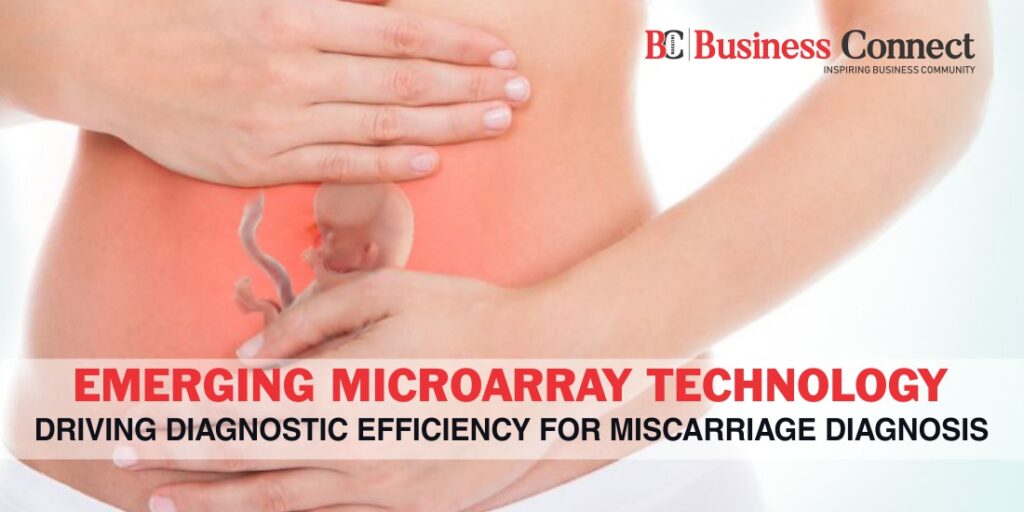Emerging Microarray Technology: Driving Diagnostic Efficiency for Miscarriage Diagnosis
Introduction
The global molecular diagnostic market is 10 billion USD and is expected to reach 12 billion USD at a CAGR of 8.4% by 2023. India’s molecular diagnostic market is nearly 920 million USD and is expected to grow at a CAGR of 10% by 2026. In recent years, there has been an increase in a sedentary lifestyle, smoking, and unhealthy diet in metropolitan cities which demands the entry of a new era of personalized health care.
This has resulted in an unprecedented number of Start-up biotechnology (molecular diagnostics) companies in India (Delhi, Gurugram, Mumbai, Chennai, Bangalore, Kerela), UK, Japan, USA (New York) providing medical genetic testing facilities for life-threatening diseases.
The services include prenatal diagnosis (For Down syndrome and trisomy 18 syndromes), detection of chromosomal abnormalities leading to recurrent pregnancy loss (RPL), carrier testing (for sickle cell anemia or cystic fibrosis), newborn screening (for congenital hypothyroidism, sickle cell anemia, Phenylketonuria) and cancer diagnosis (breast cancer).
What is Miscarriage?
Miscarriage or pregnancy loss, the natural spontaneous loss of baby, is reported to be about 15%-20% of clinical pregnancies in the fertile population and varies according to age. About 1–2% of couples suffer from recurrent pregnancy loss (RPL) (3 consecutive pregnancy losses before 20 weeks from the last menstrual period), the reason behind being solely genetic.
Several different types of risk factors for miscarriage, which can involve the mother, the baby, or both, are parental chromosomal abnormalities, maternal age (≥ 35 years), lifestyle factors (smoking, alcohol & use of illegal drugs), endocrine irregularities, congenital (birth defects) and acquired uterine anomalies, autoimmune factors, etc.
Traditionally standard cytogenetic analysis has been used for detecting most chromosomal abnormalities in pregnancy loss which are mostly aneuploidies (abnormal number of chromosome 45 or 47). However, the classical method requires live dividing cells, which requires culture and the challenge for products of conception (POCs) remains as the possibility of culture failure is high, selective overgrowth of maternal cells in culture can give misleading results, contamination due to microbes and poor chromosome morphology, frequently hinder obtaining high‐quality results in pregnancy loss cases.
Types of Miscarriage
There are 12 types of miscarriage.
- Complete Miscarriage (Expulsion of a complete fetus out of the uterus, extreme abdominal pain, severe vaginal bleeding, and expulsion of POCs).
- Incomplete Miscarriage (Symptoms similar to Complete miscarriage, cervix remain open).
- Threatened Miscarriage (Vaginal bleeding in the 1st tri semester of pregnancy when cervix remains closed).
- Inevitable Miscarriage (Heavy bleeding and severe cramps).
- Recurrent Miscarriage (3 consecutive pregnancy loss).
- Missed Miscarriage (Fetus dies early and remain in mother’s uterus).
- Blighted Ovum (Attachment of fertilized egg to the uterus wall but doesn’t develop into an embryo).
- Chemical Miscarriage (Early loss during 4th or 5th pregnancy week).
- First-Trimester Miscarriage (Takes place during 1st 12 weeks of gestation period).
- Second Trimester Miscarriage (Occurs rarely between 12th to 20th weeks of pregnancy).
- Ectopic Miscarriage (Implantation of an embryo outside the uterus).
- Molar Pregnancy (Development of pregnancy tissue into an abnormal growth).
Recurrent Pregnancy Loss (RPL)
It refers to the consecutive occurrence of 3 or more pregnancy losses. According to reports, there are a low number of cases of recurrent miscarriages. In India, there have been reports of recurrent miscarriages of about 10%.
History of Microarray Technology
The concept of DNA microarray technology which evolved from Southern blotting was proposed by Augenlicht and colleagues in the late 1980s. The genetic material is efficiently analyzed by this technology which is used for the study of large-scale gene expression. Mark Schena is considered as “Father of Microarray technology”.
Role of Microarray
Recently developed Microarray technology is a powerful biotechnology technique that involves the analysis of thousands of DNA samples simultaneously. DNA extracted from direct fetal samples is used in these methods which do not require live cells. Furthermore, the detection ability of chromosomal abnormalities through chromosomal microarrays is quite significantly below the resolution of karyotyping. Therefore, DNA microarray for pregnancy loss is a promising tool of chromosome analysis than conventional karyotyping because of enhanced diagnostic yield.
Summary
DNA microarray testing is a preferable, robust method of analyzing cases of recurrent pregnancy loss to better delineate possible genetic etiologies, regardless of gestational age, because of its high diagnostic sensitivity. Single nucleotide polymorphism (SNP) based Chromosomal microarray testing can detect aneuploidy, polyploidy (more than two sets of the chromosome), segmental genomic imbalances, whole-genome homozygosity, and maternal cell contamination, thus showing a high degree of sensitivity and decrement in false-negative results.
A better understanding of the etiology of fetal loss helps to know the reason for recurrence risk and helps in planning and management for future family planning by newly married couples.



